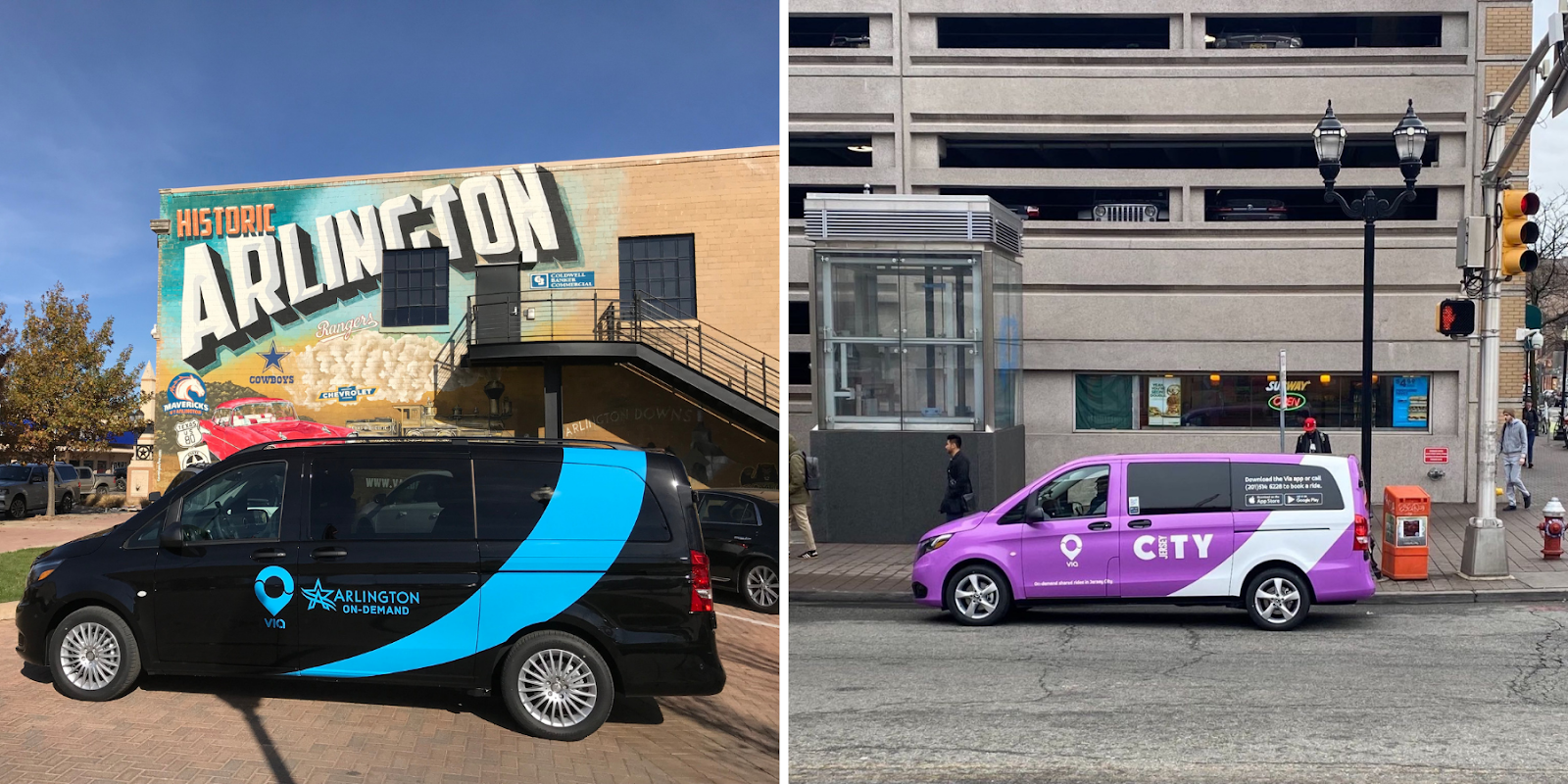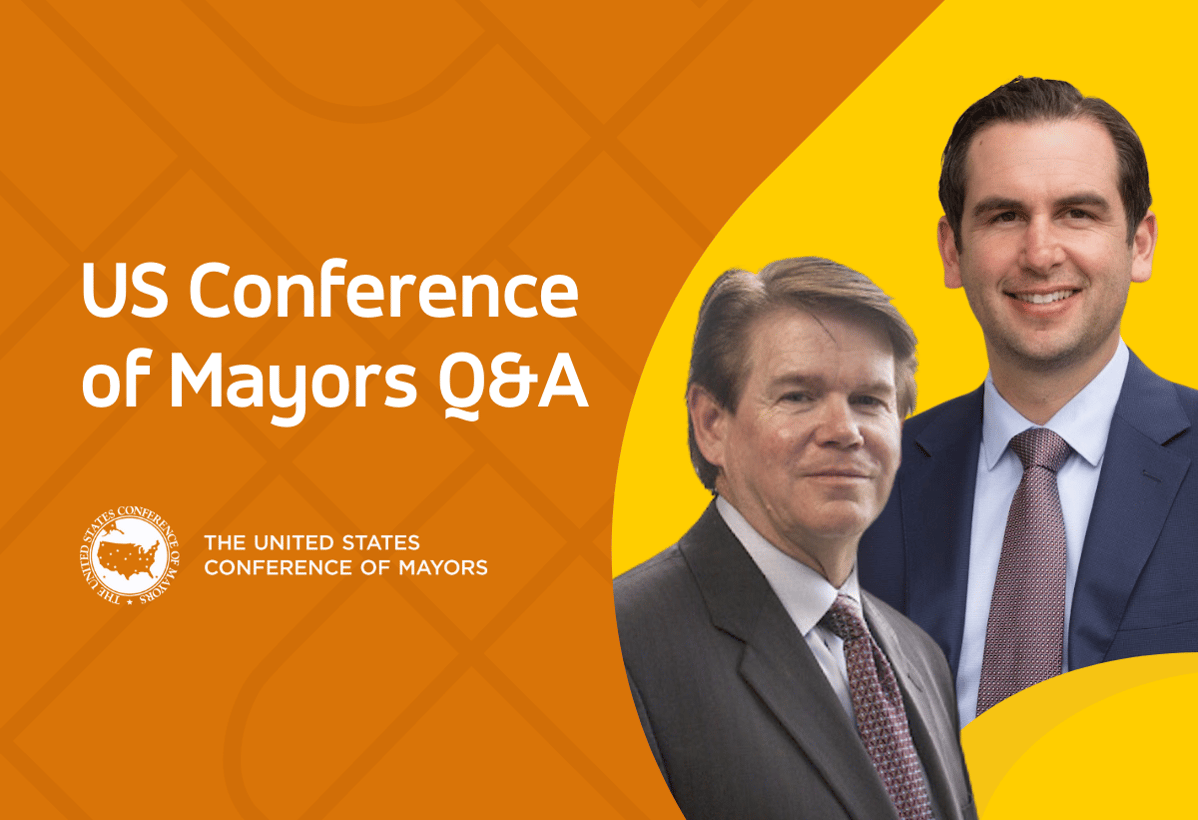Mayors on microtransit: How local governments can influence and implement transit solutions for their residents. from Via on Vimeo.
In partnership with the US Conference of Mayors , we recently hosted a roundtable discussion with two forward-thinking city leaders: Mayor Jeff Williams (Arlington, Texas) and Mayor Steven Fulop (Jersey City, New Jersey). With questions from Via’s Director of Policy, Ya-Ting Liu and fellow mayors themselves, these leaders pulled back the curtain on their respective services — Via Arlington and Via Jersey City — openly discussing everything from funding sources, to equity data and customer satisfaction ratings. You can watch the full conversation, or preview the clips and read the Q&A below for some standout moments.
VIA: A lot of times in cities, the transit service being provided within the city limits is a creature of some other entity, like a state, county, etc. What would be your advice for other mayors that are looking at their communities and thinking: “We need more access, but how do I get started?”
MAYOR FULOP: If you take a step back and you think about the kind of the transportation infrastructure in your respective city — use buses as an example — it tends to be tremendously inefficient. By that I mean, regardless of whether it has passengers or not, it's traveling down the street on a fixed route and making those stops. It's not really helpful for the environment and it's not really an efficient way to move people to get directly to where they want to go. The reason that you have a bus system is because it's cheap, so people find it economically beneficial to use the bus and, even though it's not the most efficient way to move around the city, it works for people. If you go to the other side of the spectrum on transportation you think about, let's say, an Uber — it's obviously more flexible, it will pick you up in front of your home, but it's more expensive and cost-prohibitive for the target population that we're talking about.

What Via has done for us is created the best of both worlds, so we have a flexible system that isn't traveling around the streets unless they have a reason to travel around the streets and they're picking up multiple people at the same time that are headed in the same direction, because the efficiency of the technology allows them to do it…. So the first step is just putting out an RFP and starting the conversation based on what you want to accomplish, and there are solutions out there from a technology standpoint.
MAYOR WILLIAMS: We have influence…. It may not be the city that's controlling transit, but you can influence your transit agency to be innovative, to recognize that there are more tools than just light rail and buses now that we have at our disposal and we have to continue to look — that term ‘lifelong learner’ has never been more important because we have got to be ready for the changes that are here. And then the beauty of this is that we in the public sector are always looking to save money. Well, most of these technologies save us money and improve safety.
VIA: We have a fellow mayor that is now the United States Department of Transportation (USDOT) Secretary. I'm curious: What would you say if former Mayor Pete Buttigieg called you both and said, “We're about to embark on a new federal transportation bill, what would be your priorities? What would you like to see as mayors that are innovating in the public transportation space?”
MAYOR WILLIAMS: Secretary Pete is the epitome of a lifelong learner…. Because of the US Conference of Mayors, I had a meeting with the President and Vice President of the United States and we got on this topic and I mentioned the fact that we are so glad to see Secretary Pete there in that position, but also the importance of technology innovation as we move forward. And the Vice President immediately said “Yes, we have got to include that in our next infrastructure bill!” Well, I’m looking forward here in the next few weeks to actually have a few minutes with Secretary Pete and talk about that. I’m one of the few engineers that is a mayor and I’m so excited about the opportunity of infrastructure, and I think it's so timely because now we do have many, many options for us in transportation but it's critical that in this next infrastructure bill that technology innovation be included.
MAYOR FULOP: I’m going to piggyback on that and say that I’m excited to have a mayor's perspective there. If you think about transportation at the federal level over the last several decades, it's really focused on the status quo: Figuring out how to plug budget holes within infrastructure that may be antiquated, for all intents and purposes, or investing in federal highway systems. Here you have a mayor’s perspective that understands that there is nobody who knows his city better than the respective mayor there. And understands that moving around a city is one of the biggest challenges that exists across the entire country and that becomes a big obstacle with regards to economic mobility, finding better job opportunities, caring for your family better, and having more time. So having somebody who understands all that, I think, is an absolute game changer.
VIA: Electrification of transportation has been a huge source of policy discussion at the national level as well because transportation is the number one source of greenhouse gas emissions overall in the country. So there's a lot of renewed focus on looking at how we shift this and I was curious to know your thoughts, as mayors, and your perspective on electrifying public fleets.
MAYOR WILLIAMS: We had an independent study determine that the on-demand service was the single most effective greenhouse gas emission reducer in our entire North Texas region. Because we are literally taking people out of their single passenger vehicle or taxi. And here in Arlington we have also provided affordable access to 140,000 jobs…. And then we’re hopeful, as electric vehicles do come down in price, that we can work with Via to start converting to electric.
MAYOR FULOP: We do get data from Via around the carbon footprint and the number of vehicles that we've been able to take off the street during that quarter with the on-demand transportation system that we're using, so that's really helpful.
With regards to electrifying our fleet, what you're seeing in Jersey City is that we do our best to practice what we preach. We're converting our municipal vehicles over to electric where possible, we're buying electric garbage trucks and messenger vehicles — so, anywhere that there is a competitive option that will have a similar service and reliability, we're moving in that direction.
I mean, we're not quite ready for electric police vehicles or electric fire trucks yet but one day we will and we'll explore that. But in the meantime it's important to be using the electric vehicles that are available and then having partners who — when you do something like we're doing with this rideshare model — are moving toward the electrifying option…. So as we're putting charging stations around the city and we're telling people the importance of being conscious of climate change, it's important we're also practicing what we preach and this is a good model to be able to do that.




